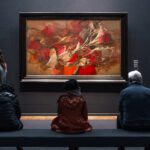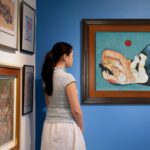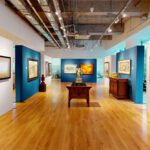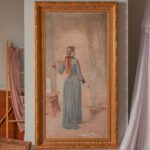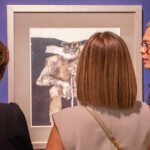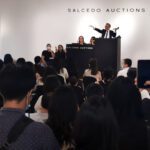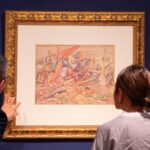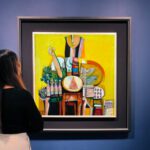Mariano Benlliure y Gil was a Spanish sculptor notable for his many public monuments celebrating notable Spanish figures, such as that of King Alfonso XII in Madrid and Queen Isabel la Católica in Granada. He is known as the last master of 19th century realism – his sculptures characterized by careful executions of everyday events and persons. Mariano and his brother Juan Antonio, a painter, are also known for their close friendship with the 19th century Philippine master and hero Juan Luna y Novicio.
Artists in Rome
In his pursuit of his dream to become a painter, Luna sailed to Europe in 1877. A year later, he accompanied his mentor Alejo Vera to Rome as an assistant. There, Luna made the acquaintance and friendship of the Benlliure brothers, Spanish pensionados who were also in Rome at that time for their studies. When Vera departed for home, Luna stayed behind and joined the Benlliures in an apartment on Via Marguita, a street where many other struggling artists were residing. Theirs would be a lifelong and loyal friendship, with Luna portraying Lucrecia Arana, the sculptor’s wife, who was one of the most famous zarzuela singers of the time.
Through Luna, the Benlliures forged friendships with other Filipino artists such as Félix Ressurección Hidalgo and Miguel Zaragoza. Several members of their pensionado group participated in the Exposición Nacional de Bellas Artes in 1884, obtaining various awards: Luna, the First Class Medal for Spoliarium; Hidalgo, Second Class Medal for Las Virgenes Cristianas Expuestas al Populacho; Juan Antonio Benlliure, Second Class Medal for De él Por la Patria; and Mariano Benlliure, a Second Class Medal for his sculpture Accident!
In the same year, Mariano created a bust of Luna, perfectly capturing the brash youthfulness and confidence of the 27 year-old artist.
Benlliure’s Lost Waxing Process
Benlliure adopted the “lost wax” technique for casting his artworks, overseeing each step of this intricate process. From the initial clay model to the casting stages involving plaster, wax, and bronze, he ensured meticulous control and retouching. This approach guaranteed that no two bronze castings of the same sculpture were identical, rendering each piece truly unique and original.
Benlliure’s artistic style demonstrates a seamless fusion of intricate naturalism and a spontaneous impressionistic quality. His sculptures exhibit a distinctive ability to harmonize materials, often employing marble and bronze, to achieve exquisite surface textures. There is careful attention to the intricate details of his models, lavishing particular attention on elements like individual hair strands, facial characteristics, and even finer points like a moustache. He deliberately empties the irises, giving a lifelike quality to its gaze.
The bust on offer stands at 16 inches, with a slim base bearing Luna’s full name, “Juan Luna y Novicio.” Inscribed at its nape is “M. Benlliure[,] Rome[,] 1884” – indicating that its mold was made within that year. Chiseled also at its base is the name “Mir y Ferrero Fundidores-Madrid,” the foundry whose name mostly appears in Mariano’s works. According to the Fundación Mariano Benlliure, who graciously authenticated the artwork, Mariano began working with Mir y Ferrero Fundidores in 1920, dating the bronze casting of this bust at or around this year.
Possible Provenance
Records show that a bronze bust of Juan Luna by Mariano, together with a copy of the Spoliarium painted by Juan Antonio, was commissioned by Don Vicente Palmori, Consul General of Spain. Palmori was a personal friend of Luna back in Rome in 1883, and it is written that these works were presented to the then Philippine Governor General Leonard Wood on October 21, 1922 at the Marble Hall of the Ayuntamiento Building in Intramuros.
Wood created a Committee on Arrangements through Executive Order No. 54 of 1922 for the ceremony of delivery of these artworks. The committee was headed by Don Fernando Zóbel, with the Spanish consul general heading the Committee on Presentations and the Governor General serving as chairman, representing the Philippine colonial government. The Spoliarium copy was hung at the Legislative Building while the bust was exhibited at the Philippine Library and Museum in Quiapo, later being transferred to the National Library. Both works were lost during the battle for the liberation of Manila in 1945.
It was further written that in the aftermath of the War, a “junk collector presumably retrieved it [the bust] from the rubble” and sold it to a junk dealer or magbabakal for Php5.00–not so much for its historical value but more probably for its bronze content. The junk dealer then offered it to Elsie “Inday” Cadapan, an influential social realist Filipino artist, who also used to run an antique store at the Mabini Arts Center in the 1970s. It was Cadapan who in 1979 sold the bust to East Asia Corporation for Arts & Antiquities, an affiliate of Multinational Investment Bancorporation engaged in art dealership and brokerage that later merged with the institution, via its managing director Amado Lacuesta.
Filipinas Heritage Library catalogs an identical bust with the same dimensions. It also notes a similar account of the bust being found by a “pushcart vendor during the Liberation,” but this time names a certain Ireneo Cristobal, a religious sculptor of Taller de Escultura in Manila, to have bought it from the pushcart vendor and subsequently turned down many tempting offers from collectors to buy it. Filipinas Heritage Library for its part did not mention the ownership of the bust at the time it was catalogued. However, Fundación Mariano Benlliure did a comparative study of the busts’ photos. They came to the conclusion that both busts are the same, citing a significant detail that is a dark spot next to the rightmost lock of hair on the forehead, apart from many other modeling details.
While there is corroborated evidence that the bust was transacted between Ireneo Cristobal and Elsie Cadapan, Salcedo Auctions cannot fully ascertain if the bust lost in the war is the same bust that Ireneo Cristobal bought for Php 5.00. It is also important to note that an identical-looking bust was featured on the cover of Chronicle Magazine on December 9, 1967, which is quite possibly the same as the one referred to in the aforementioned accounts. Given this information, it is the opinion of Salcedo Auctions that this presents a possible line of provenance of the work, adding further sheen to the historical importance of what is only the second known original and authentic bust portrait of Juan Luna y Novicio by his beloved artistic confrere.
Three Busts, Two Benlliures
There are three busts of Juan Luna y Novicio by Benlliure known to be in existence, two originals by the artist, and a third one, a casted copy of the sculpture on offer. To protect their Benlliure, Multinational Investment Bancorporation (now known as MIB Capital Corporation) commissioned a replica in 1982 from Mulawin Abueva, son of National Artist Napoleon Abueva and also an artist in his own right. In order to safeguard the authenticity of the artwork, and out of respect for Benlliure, Abueva removed the signatures and inscriptions from the replica, which was displayed in the institution’s public area, while the original was kept safe in a vault.
The other Luna bust is one of the prized artworks in the collection of the University of Santo Tomas (UST) Museum. It is taller by three inches – a bronze-painted plaster bust that portrays a seemingly slightly older Luna in a suit. Fundación Mariano Benlliure dates this piece to around 1887.
Salcedo Auctions gratefully acknowledges the Fundación Mariano Benlliure for authenticating this artwork and for the catalogue entry.
—
The Well-Appointed Life live and online auction takes place on 16 September 2023 at 2PM. Preview runs from Thursday September 8 to Friday September 15 at the Salcedo Auctions, NEX Tower 6786 Ayala Avenue, Makati City. The gallery is open on Tuesdays to Fridays, 9AM-6PM and Saturdays, 9AM-4PM.
Register to bid for the upcoming The Well-Appointed Life September edition. View the eCatalogue via this link.
References:
- Da Silva, C. E. “JUAN LUNA Y NOVICIO, 1st Internationally known Filipino Painter.” mimeograph, Oct. 1957, p. 23.
- Ibid. p. 35 quoted by Isidra Reyes, 15 May 2023, 6:28 PM. Facebook.
- Filipinas Heritage Library. Mariano M. Benlliure: Bust of Juan Novicio Luna.1884. www.filipinaslibrary.org.ph/biblio/940
- Fundación Mariano Benlliure. marianobenlliure.org
- Lacuesta, Amado. East Asia’s & UST’s Luna busts… Unpublished notes. 1982.
- Lacuesta, Amado. Bronze Bust of JUAN LUNA Y NOVICIO by Mariano Benlliure in Rome, 1884. Unpublished notes. (n. d.)
- Real Academia de Bellas Artes de San Fernando. Mariano Benlliure: El dominio de la materia. 2013. gestiona3.madrid.org/bvirtual/BVCM019041.pdf














